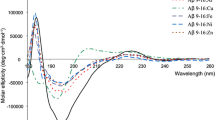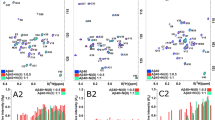Abstract
The region 1–16 of the amyloid-β peptides associated with Alzheimer’s disease can be considered as the metal-binding domain, and the residues His6, His13, and His14 have been identified as ligands that coordinate heavy metal ions. To establish the role played by the three histidine residues of the Aβ(1–16) sequence in binding metal ions, two variants of Aβ(1–16) peptide fragment (H-1DAEFRHDSGYEVHHQK16-NH2) were synthesized by Fmoc/tBu Solid Phase Peptide Synthesis strategy and purified by RP-HPLC. The three histidine residues were replaced by either three serine residues to form Ser-Aβ(1–16): H-1DAEFRSDSGYEVSSQK16-NH2 or three alanine ones to form Ala–Aβ(1–16): H-1DAEFRADSGYEVAAQK16-NH2. The three peptides were comparatively characterized by mass spectrometry (MS), circular dichroism spectroscopy (CD) and atomic force microscopy (AFM), being subsequently used to study their interaction with metal ions at various pH values. During our experiments, significant pH-dependent changes in the conformation of these peptides have been observed and reported. AFM images showed dramatic changes in the film morphology of peptides upon binding metal ions. In the MS spectra we have unambiguously identified several metal–peptide molecular ions, thus confirming the affinity of Aβ(1–16) peptides to copper and nickel ions. The newly synthesized peptides may bring new evidence on the relationship of histidine residues in amyloid-β peptides with metal ions. In addition, new directions for research and experimental works are suggested.













Similar content being viewed by others
References
Abdrakhmanov R, Blokhin D, Usachev K, Karataeva F, Klochkov V (2017) NMR studies of the Mn2+ interactions with amyloid peptide Aβ13–23 in water environment. BioNanoScience 7:204–206. https://doi.org/10.1007/s12668-016-0317-7
Andrew RJ, Kellett KA, Thinakaran G, Hooper NM (2016) A Greek tragedy: the growing complexity of Alzheimer amyloid precursor protein proteolysis. J Biol Chem 291:19235–19244. https://doi.org/10.1074/jbc.R116.746032
Behrendt R, White P, Offer J (2016) Advances in Fmoc solid-phase peptide synthesis. J Pept Sci 22:4–27. https://doi.org/10.1002/psc.2836
Bolognin S, Messori L, Zatta P (2009) Metal ion physiopathology in neurodegenerative disorders. Neuromol Med 11:223–2328. https://doi.org/10.1007/s12017-009-8102-1
Cai C, Lin J, Chen T, Tian X (2010) Aggregation behavior of graft copolymer with rigid backbone. Langmuir 26:2791–2797. https://doi.org/10.1021/la902834m
Chen YR, Huang HB, Chyan CL, Shiao MS, Lin TH, Chen YC (2006) The effect of Aβ conformation on the metal affinity and aggregation mechanism studied by circular dichroism spectroscopy. J Biochem 139:733–740. https://doi.org/10.1093/jb/mvj083
Clippingdale AB, Wade JD, Barrow CJ (2001) The amyloid-β peptide and its role in Alzheimer's disease. J Pept Sci 7:227. https://doi.org/10.1002/psc.324
Coin I, Beyermann M, Bienert M (2007) Solid-phase peptide synthesis: from standard procedures to the synthesis of difficult sequences. Nat Protoc 2:3247–3256. https://doi.org/10.1038/nprot.2007.454
Donadio G, Di Martino R, Oliva R, Petraccone L, Del Vecchio P, Di Luccia B, Ricca E, Isticato R, Di Donato A, Notomista E (2016) A new peptide-based fluorescent probe selective for zinc (ii) and copper (ii). J Mater Chem B 4:6979–6988. https://doi.org/10.1039/C6TB00671J
Faller P, Hureau C (2009) Bioinorganic chemistry of copper and zinc ions coordinated to amyloid-β peptide. Dalton Trans 7:1080–1094. https://doi.org/10.1039/B813398K
Fraser PE, Nguyen JT, Surewicz WK, Kirschner DA (1991) pH-dependent structural transitions of Alzheimer amyloid peptides. Biophys J 60:1190–1201. https://doi.org/10.1016/S0006-3495(91)82154-3
Gaggelli E, Grzonka Z, Kozłowski H, Migliorini C, Molteni E, Valensin D, Valensin G (2008) Structural features of the Cu (II) complex with the rat Aβ (1–28) fragment. Chem Commun 3:341–343. https://doi.org/10.1039/B713453C
Ghalebani L, Wahlström A, Danielsson J, Wärmländer SK, Gräslund A (2012) pH-dependence of the specific binding of Cu (II) and Zn (II) ions to the amyloid-β peptide. Biochem Biophys Res Commun 421:554–560. https://doi.org/10.1016/j.bbrc.2012.04.043
Istrate AN, Tsvetkov PO, Mantsyzov AB, Kulikova AA, Kozin SA, Makarov AA, Polshakov VI (2012) NMR solution structure of rat Aβ (1–16): toward understanding the mechanism of rats' resistance to Alzheimer's disease. Biophys J 102:136–143. https://doi.org/10.1016/j.bpj.2011.11.4006
Istrate AN, Kozin SA, Zhokhov SS, Mantsyzov AB, Kechko OI, Pastore A, Makarov AA, Polshakov VI (2016) Interplay of histidine residues of the Alzheimer’s disease Aβ peptide governs its Zn-induced oligomerization. Sci Rep 6:21734. https://doi.org/10.1038/srep21734
Johnson RA, Manley OM, Spuches AM, Grossoehme NE (2016) Dissecting ITC data of metal ions binding to ligands and proteins. Biochimica et Biophysica Acta (BBA) 1860:892–901. https://doi.org/10.1016/j.bbagen.2015.08.018
Jureschi M, Lupaescu AV, Ion L, Petre BA, Drochioiu G (2019) Stoichiometry of heavy metal binding to peptides involved in Alzheimer’s disease: mass spectrometric evidence. In: Woods AG, Darie CC (eds) Advancements of mass spectrometry in biomedical research. Springer, Cham, pp 401–415. https://doi.org/10.1007/978-3-030-15950-4_23
Kobayashi S, Tanaka Y, Kiyono M, Chino M, Chikuma T, Hoshi K, Ikeshima H (2015) Dependence pH and proposed mechanism for aggregation of Alzheimer’s disease-related amyloid-β (1–42) protein. J Mol Struct 1094:109–117. https://doi.org/10.1016/j.molstruc.2015.03.023
Kozlowski H, Janicka-Klos A, Brasun J, Gaggelli E, Valensin D, Valensin G (2009) Copper, iron, and zinc ion homeostasis and their role in neurodegenerative disorders (metal uptake, transport, distribution and regulation). Coord Chem Rev 253:2665–2685. https://doi.org/10.1016/j.ccr.2009.05.011
Lin CJ, Huang HC, Jiang ZF (2010) Cu (II) interaction with amyloid-β peptide: a review of neuroactive mechanisms in AD brains. Brain Res Bull 82:235–242. https://doi.org/10.1016/j.brainresbull.2010.06.003
Liu T, Yin J, Wang Y, Miao P (2016) Construction of a specific binding peptide based electrochemical approach for sensitive detection of Zn2+. J Electroanal Chem 783:304–307. https://doi.org/10.1016/j.jelechem.2016.11.006
Ma QF, Hu J, Wu WH, Liu HD, Du JT, Yong-Wei YF, Lei WP, Zhao YF, Li YM (2006) Characterization of copper binding to the peptide amyloid‐β (1–16) associated with Alzheimer's disease. Biopolymers 83:20. https://doi.org/10.1002/bip.20523
Makowska J, Żamojć K, Wyrzykowski D, Żmudzińska W, Uber D, Wierzbicka M, Wiczk W, Chmurzyński L (2016) Probing the binding of Cu2 + ions to a fragment of the Aβ (1–42) polypeptide using fluorescence spectroscopy, isothermal titration calorimetry and molecular dynamics simulations. Biophys Chem 216:44–50. https://doi.org/10.1016/j.bpc.2016.06.006
Makowska J, Kamrowski D, Żamojć K, Wyrzykowski D, Chmurzyński L (2018a) Influence of amino acids sequence on metal binding properties of selected pentapeptides-fluorescence and UV-Vis spectroscopy studies. Appl Biosci 1(3):19–20. https://doi.org/10.31708/spi3.18/makdo.cns18
Makowska J, Żamojć K, Wyrzykowski D, Wiczk W, Chmurzyński L (2018b) Copper (II) complexation by fragment of central part of FBP28 protein from Mus musculus. Biophys Chem 241:55–60. https://doi.org/10.1016/j.bpc.2018.08.002
McGlinchey RP, Jiang Z, Lee JC (2014) Molecular origin of pH-dependent fibril formation of a functional amyloid. Chembiochem 15:1569–1572. https://doi.org/10.1002/cbic.201402074
Mentler M, Weiss A, Grantner K, Del Pino P, Deluca D, Fiori S, Renner C, Klaucke WM, Moroder L, Bertsch U, Kretzschmar HA, Tavan P, Parak FG (2005) A new method to determine the structure of the metal environment in metalloproteins: investigation of the prion protein octapeptide repeat Cu2+ complex. Eur Biophys J 34:97–112. https://doi.org/10.1007/s00249-004-0434-z
Minicozzi V, Stellato F, Comai M, Serra MD, Potrich C, Meyer-Klaucke W, Morante S (2008) Identifying the minimal copper-and zinc-binding site sequence in amyloid-β peptides. J Biol Chem 283:10784–10792. https://doi.org/10.1074/jbc.M707109200
Murariu M, Habasescu L, Ciobanu CI, Gradinaru RV, Pui A, Drochioiu G, Mangalagiu I (2019) Interaction of amyloid Aβ (9–16) peptide fragment with metal ions: CD, FT-IR, and fluorescence spectroscopic studies. Int J Pept Res Ther 25(3):897–909. https://doi.org/10.1007/s10989-018-9738-1
Murariu M, Dragan ES, Drochioiu G (2010) Model peptide-based system used for the investigation of metal ions binding to histidine‐containing polypeptides. Biopolymers 93:497–508. https://doi.org/10.1002/bip.21385
Nhan HS, Chiang K, Koo EH (2015) The multifaceted nature of amyloid precursor protein and its proteolytic fragments: friends and foes. Acta Neuropathol 129:1–19. https://doi.org/10.1007/s00401-014-1347-2
Nunomura A, Castellani RJ, Zhu X et al (2006) Involvement of oxidative stress in Alzheimer disease. J Neuropath Exp Neur 65:631–641 https://doi.org/10.1097/01.jnen.0000228136.58062.bf
Peri S, Steen H, Pandey A (2001) GPMAW-a software tool for analyzing proteins and peptides. Trends Biochem Sci 26:687–689. https://doi.org/10.1016/S0968-0004(01)01954-5
Rózga M, Protas AM, Jabłonowska A, Dadlez M, Bal W (2009) The Cu (ii) complex of Aβ40 peptide in ammonium acetate solutions. Evidence for ternary species formation. Chem Commun 11:1374–1376. https://doi.org/10.1039/B819616H
Shin BK, Saxena S (2008) Direct evidence that all three histidine residues coordinate to Cu(II) in amyloid-β1–16. Biochemistry 47:9117–9123. https://doi.org/10.1021/bi801014x
Stanyon HF, Cong X, Chen Y, Shahidullah N, Rossetti G, Dreyer J, Papamokos G, Paolo Carloni P, Viles JH (2014) Developing predictive rules for coordination geometry from visible circular dichroism of copper (II) and nickel (II) ions in histidine and amide main-chain complexes. FEBS J 281:3945–3954. https://doi.org/10.1111/febs.12934
Suprun EV, Khmeleva SA, Radko SP, Archakov AI, Shumyantseva VV (2016) Electrochemical analysis of amyloid-β domain 1–16 isoforms and their complexes with Zn (II) ions. Electrochim Acta 187:677–683. https://doi.org/10.1016/j.electacta.2015.11.111
Tipping KW, Karamanos TK, Jakhria T, Iadanza MG, Goodchild SC, Tuma R, Ranson NA, Hewitt EW, Radford SE (2015) pH-induced molecular shedding drives the formation of amyloid fibril-derived oligomers. Proc Natl Acad Sci USA 112:5691–5696. https://doi.org/10.1073/pnas.1423174112
Todorich BM, Connor JR (2004) Redox metals in Alzheimer's disease. Ann NY Acad Sci 1012:171–178. https://doi.org/10.1196/annals.1306.014
Tycko R (2014) Physical and structural basis for polymorphism in amyloid fibrils. Protein Sci 23:1528–1539. https://doi.org/10.1002/pro.2544
Valko M, Morris H, Cronin MTD (2005) Metals, toxicity and oxidative stress. Curr Med Chem 12:1161–1208. https://doi.org/10.2174/0929867053764635
Veloso A, Kerman K (2013) Advances in electrochemical detection for study of neurodegenerative disorders. Anal Bioanal Chem 405:5725. https://doi.org/10.1007/s00216-013-6904-3
Wallin C, Kulkarni YS, Abelein A, Jarvet J, Liao Q, Strodel B, Olsson L, Luo J, Abrahams JP, Sholts SB, Roos PM (2016) Characterization of Mn (II) ion binding to the amyloid-β peptide in Alzheimer’s disease. J Trace Elem Med Bio 38:183–193. https://doi.org/10.1016/j.jtemb.2016.03.009
Wang P, Wu J, Su P, Shan C, Zhou P, Ge Y, Liu D, Liu W, Tang Y (2016) A novel fluorescent chemosensor based on tetra-peptides for detecting zinc ions in aqueous solutions and live cells. J Mater Chem B 4:4526–4533. https://doi.org/10.1039/C6TB00794E
Zirah S, Kozin SA, Mazur AK, Blond A, Cheminant M, Ségalas-Milazzo I, Debey P, Rebuffat S (2006) Structural changes of region 1–16 of the Alzheimer disease amyloid β-peptide upon zinc binding and in vitro aging. J Biol Chem 281:2151–2161. https://doi.org/10.1074/jbc.M504454200
Acknowledgements
We are grateful to the anonymous reviewers for insightful and constructive comments that greatly improved this manuscript. Funding from Romanian Government by UEFISCDI Bucharest, PN-III-P4-ID-PCE-2016-0376 (Contract 56/2017) is gratefully acknowledged.
Author information
Authors and Affiliations
Contributions
For this research article LH contributed with reagents/materials, partly peptide synthesis, analyzed the data, and wrote the draft of the paper; MM & MM performed the either AFM or MS and CD experiments and partly peptide synthesis; MJ & BAP were involved in metal binding and MALDI-TOF measurements; RVG was involved in HPLC; GD conceived and designed the experiments, analyzed the data, wrote the paper.
Corresponding author
Ethics declarations
Conflict of interest
The authors declare that they have no confict of interests.
Research Involving Human Participants and/or Animals
This article does not contain any studies with human participants or animals performed by any of the authors.
Additional information
Publisher's Note
Springer Nature remains neutral with regard to jurisdictional claims in published maps and institutional affiliations.
Rights and permissions
About this article
Cite this article
Habasescu, L., Jureschi, M., Petre, BA. et al. Histidine-Lacked Aβ(1–16) Peptides: pH-Dependent Conformational Changes in Metal Ion Binding. Int J Pept Res Ther 26, 2529–2546 (2020). https://doi.org/10.1007/s10989-020-10048-0
Received:
Revised:
Accepted:
Published:
Issue Date:
DOI: https://doi.org/10.1007/s10989-020-10048-0




